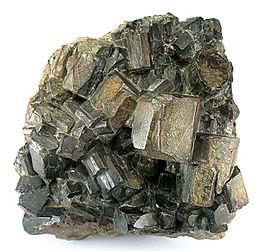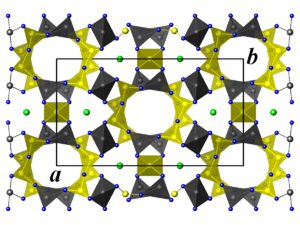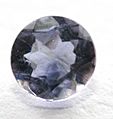Cordierite facts for kids
Quick facts for kids Cordierite |
|
|---|---|
 |
|
| General | |
| Category | Cyclosilicate |
| Formula (repeating unit) |
(Mg,Fe) 2Al 4Si 5O 18 |
| Strunz classification | 9.CJ.10 |
| Dana classification | 61.02.01.01 Cordierite group |
| Crystal symmetry | Cccm |
| Unit cell | a = 17.079 Å, b = 9.730 Å, c = 9.356 Å; Z = 4 |
| Identification | |
| Color | Blue, smoky blue, bluish violet; greenish, yellowish brown, gray; colorless to very pale blue in thin section in transmitted light |
| Crystal habit | Pseudo-hexagonal prismatic twins, as imbedded grains, and massive |
| Crystal system | Orthorhombic |
| Twinning | Common on {110}, {130}, simple, lamellar, cyclical |
| Cleavage | Fair on {100}, poor on {001} and {010} |
| Fracture | Subconchoidal |
| Tenacity | Brittle |
| Mohs scale hardness | 7 - 7.5 |
| Luster | Greasy or vitreous |
| Streak | White |
| Diaphaneity | Transparent to translucent |
| Specific gravity | 2.57 - 2.66 |
| Optical properties | Usually optically (-), sometimes (+); 2V = 0-90° |
| Refractive index | nα = 1.527 - 1.560 nβ = 1.532 - 1.574 nγ = 1.538 - 1.578 Indices increase with Fe content. |
| Pleochroism | X = pale yellow, green; Y = violet, blue-violet; Z = pale blue |
| Fusibility | on thin edges |
| Diagnostic features | Resembles quartz, can be distinguished by pleochroism. Can be distinguished from corundum by its lower hardness |
Cordierite is a fascinating mineral. In the world of minerals, it's called cordierite. But when it's used as a gemstone, it's known as iolite. This mineral is a type of silicate. It contains elements like magnesium, iron, and aluminium.
Iron is almost always found in cordierite. There are different types of cordierite depending on how much magnesium or iron it has. A special high-temperature version of cordierite is called indialite.
Contents
What is Cordierite?
Cordierite was first found in 1813. The discovery happened in Níjar, Almería, Spain. It was named after a French geologist named Louis Cordier. He lived from 1777 to 1861.
Where Can You Find Cordierite?
Cordierite usually forms in rocks that have changed due to heat and pressure. This process is called metamorphism. It's common in rocks like hornfels. These rocks are often found where hot magma has touched other rocks.
You can also find cordierite with other minerals. These include sillimanite, spinel, and garnet. Sometimes, cordierite appears in certain types of granite and pegmatite rocks. For example, it is found in the granite contact zone at Geevor Tin Mine in Cornwall.
How Cordierite is Used
Cordierite is very useful in modern technology. Many Catalytic converters are made from a special ceramic. This ceramic contains a lot of man-made cordierite.
Catalytic converters help clean car exhaust. The cordierite crystals are carefully lined up during manufacturing. This makes the material very resistant to sudden temperature changes. This prevents the converter from cracking when it gets very hot.
Iolite: The Gemstone Version
The clear and beautiful type of cordierite is called iolite. It is often used as a gemstone. The name "iolite" comes from a Greek word meaning "violet." This is because of its lovely violet-blue color.
Unique Properties of Iolite
Iolite has another old name, dichroite. This Greek word means "two-colored rock." It refers to a special property of cordierite called pleochroism. This means the mineral appears to be different colors when viewed from different angles.
Iolite was also known as "water-sapphire." Another interesting name is "Vikings' Compass." This is because Vikings may have used it to find the sun's direction. They could do this even on cloudy days. The stone helped them see the polarization of light in the sky. This showed them where the sun was, even if it was hidden.
Colors and Locations
Gem-quality iolite can show many colors. It can be sapphire blue, blue violet, yellowish gray, or light blue. The color changes depending on how the light hits it.
Iolite is sometimes used as a more affordable choice instead of sapphire. It is softer than sapphires. You can find iolite in many places around the world. These include Australia, Brazil, India, Madagascar, and the United States. The biggest iolite crystal ever found weighed over 24,000 carats. That's about 4,800 grams! It was discovered in Wyoming, USA.
Another name for blue iolite is steinheilite. This name honors Fabian Steinheil. He was a Russian military governor who noticed it was different from quartz. Praseolite is another variety of iolite. It gets its color from heat treatment. It should not be confused with prasiolite.
See also
 In Spanish: Cordierita para niños
In Spanish: Cordierita para niños
- List of minerals
- List of minerals named after people
- Sunstone (medieval)




